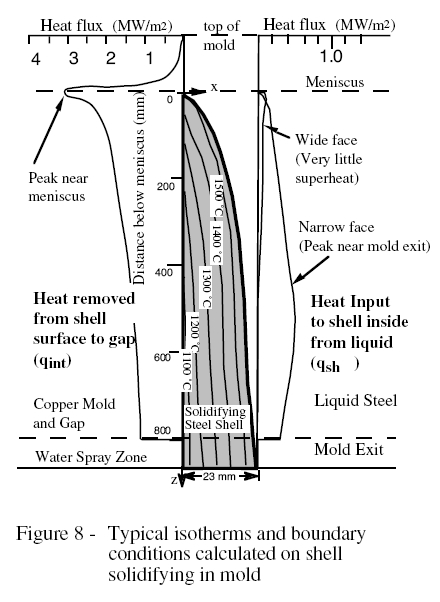|
Interfacial Heat Transfer
David Lui and Brian Thomas
Continuous Casting Consortium
Heat transfer in continuous casting molds is controlled primarily by heat conduction across the interface between the solidifying steel shell and the water-cooled copper mold. Controlled measurements of this heat transfer are difficult and are complicated by the formation of air gaps, which greatly reduce the heat transfer. Simple heat conduction models are being used to characterize this heat transfer in a way that is consistent with both theory and available temperature data. To calibrate this model, thermocouple measurements to calculate this heat transfer are being made at LTV Steel along with the corresponding casting conditions and shell surface shape, (which indicates the extent of the gaps that reduce heat transfer). In conjunction with the 2-D thermal model, the effect of oscillation marks on heat transfer has been investigated and quantified. Oscillation marks appear to be filled with liquid flux, and act together to reduce heat transfer significantly. The ultimate goal is to understand and quantify the fundamental phenomena so that the model can predict heat transfer, shrinkage, and stress under arbitrary casting conditions without the need for explicit experimental data.

Publications:
David T. Lui, "Effect of Oscillation Marks on Heat Transfer in Continuous Casting Molds", MS Thesis, University of Illinois, 1995.
Thomas, B.G., D. Lui and B. Ho, "Effect of Transverse Depressions and Oscillation Marks on Heat Transfer in the Continuous Casting Mold" (TMS Annual Meeting, Orlando, FL, Feb. 9-13, 1997), in Sensors and Modeling in Materials Processing: Techniques and Applications, S. Viswanathan, R.G. Reddy and J.C. Malas eds., TMS, Warrendale, PA, 1997, pp. 117-142. Click here for a PDF version. (663 KB)
|

